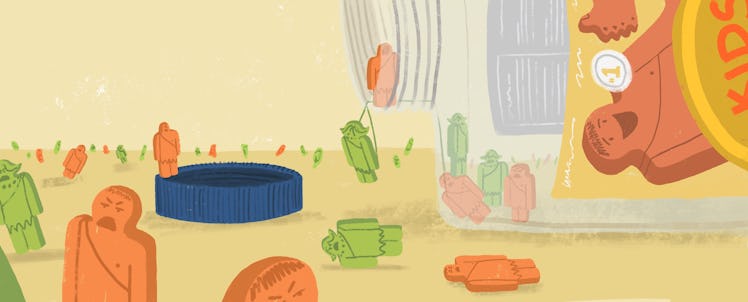Vitamins For Kids Are Unnecessary, Expensive, And Potentially Harmful
More is definitely not better when it comes to vitamins and supplements.

It’s probably time to stop feeding your kids multivitamins. A daily, candy-coated pill or gummy may seem like an easy way to give your child all the nutrients they need for their health, but, more often than not, these supplements are a waste of your money. In extreme cases, they can be downright dangerous.
For starters, the American Academy of Pediatrics (AAP), the leading authority on children’s health in the United States, does not recommend multivitamins for healthy children. Why? Most children don’t need them, megadoses of vitamins can be toxic, and you often don’t really know what you’re getting when you buy a multivitamin. In other words, buying vitamins for kids shouldn’t be the default — it should be the exception.
To grow and thrive, healthy children need small amounts of essential vitamins — like A, B, C, D, and K. Most children can easily get all they need just from the foods they eat, says George Fuchs, a pediatric gastroenterologist at the University of Kentucky and member of AAP’s Committee of Nutrition. Many foods are fortified with different vitamins, so even picky eaters are likely getting plenty of nutrients.
“If a child is otherwise healthy, they should get everything they need from their diet,” says Fuchs.
And more is definitely not better when it comes to vitamins. There’s no benefit to giving your child more than the recommended levels of vitamins. What’s more, vitamins can interfere with certain medications your child takes, according to the Mayo Clinic. And megadoses of certain vitamins, while rare, can have serious consequences.
If your child gets a heavy overdose of water-soluble vitamins, like vitamin B, they’ll probably just pee it all out, says Fuchs. But fat-soluble vitamins, like A and D that are stored in the body and released over time, can build up to toxic levels in the blood. Extremely high levels of vitamin A can cause vomiting, brain swelling, and distorted vision, says Fuchs. Megadoses of vitamin D can bring nausea and vomiting, liver damage, and high levels of calcium in the blood, which can mess with heart function.
Then there’s the fact that when you buy a multivitamin you often don’t actually know what you’re getting because you can’t always trust what’s on the bottle. While these supplements are technically regulated by the Food and Drug Administration, there is little actual oversight of the industry, according to Consumer Labs, a company that independently tests health and nutrition products.
In a test of 35 popular multivitamins on the market today, Consumer Labs found 46 percent actually contained far higher or far lower vitamin levels than claimed on the bottle or failed to list all ingredients. Gummy vitamins, a popular choice for children, proved more likely to fail the test than other vitamin types. Many of the tested supplements had levels of nutrients, like folic acid, far higher than they claimed and sometimes far above what is recommended for children. The Consumer Labs review noted that this is likely due to how difficult gummies are to manufacture.
Contamination by heavy metals like arsenic, cadmium, and lead can also be a concern in some products. However, Consumer Labs did not find any trace levels of these pollutants in their lab tests.
There are, of course, exceptions. Supplemental vitamins D and iron are often recommended for breastfeeding infants, says Fuchs. Children on a vegetarian diet or with certain medical conditions may also benefit from supplements, he says. The same may hold true for children at risk for vitamin D deficiency. If you think your child needs supplemental vitamins, be sure to talk with a pediatrician first to get the right levels of the right vitamins.
But the default shouldn’t be a multivitamin — it should be offering a well-balanced, healthy diet in place of a multivitamin. Your child probably doesn’t need them — and is likely better off without them.
This article was originally published on